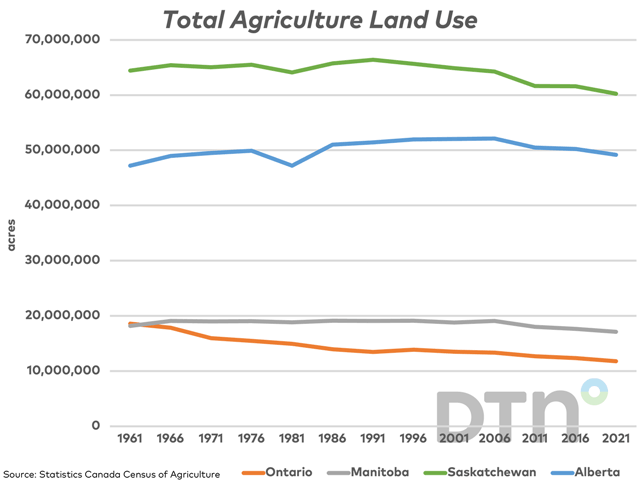Canada Markets
CAPI Explores Challenges Facing Canadian Agriculture
"They are not making anymore farmland" is something that I've heard over and over from family members and neighbours growing up on the farm in Saskatchewan. This was well before the expansion seen in cropland in places like Russia and Brazil, although when the focus is on Canada, the saying holds true to this day.
Land use was just one of the topics in a study released by The Canadian Agri-Food Policy Institute (CAPI) this week titled Competing Pressures on Land Use in Canadian Agriculture: To Intensify or Not to Intensify -- That is the Question. (https://capi-icpa.ca/…)
In an interview with the Canadian Press, Managing Director of CAPI Tyler McCann stated "We need to grow more food on less land and in a volatile climate," in summarizing the report.
The study points to the growing needs as the global population is expected to grow to 9.7 billion by 2050, urban populations grow and incomes increase. This comes at a time when biofuel demand is growing rapidly, while production is challenged by the changing climate. The study quoted OECD studies that say that crop yield growth will account for 80% of crop production increases to 2031, linked to higher input use, improving genetics and management practices.
Note that this comes at a time when government climate initiatives have placed fertilizer use under the microscope and threats of government action remain in Canada and abroad.
P[L1] D[0x0] M[300x250] OOP[F] ADUNIT[] T[]
It is interesting to note that the study reported that only 7% of Canada's land is used for agriculture, of which 66% is cropped and 34% is used for grazing. While not shown on the attached graphic, Census of Agriculture data shows Canadian agriculture land falling from 172.5 million acres in 1961 to 153.4 million acres in 2021. While there was an 11% drop over this period, the drop is reported at 4% from the 2011 to 2021 census reports.
The attached graphic highlights a 37% drop in agriculture land in Ontario during the 60-year period, a 5.8% drop in Manitoba, a 6.4% drop in Saskatchewan and a 4.1% increase in Alberta.
It is hard to imagine the fight to save farmland will end. Canada's population is shown at 38 million people as of 2021, with 500,000 immigrants per year to be added from 2023 to 2025. A housing crisis remains across the country.
In the province of Ontario, Bill 97, also called the Helping Homebuyers, Protecting Tenants Act, has passed this week and is on the way to receive Royal Ascent. This bill will make it easier for cities to expand their boundaries outwards "at any time" in order to build single family homes on land currently slated for agriculture or industry. An even more controversial part of the Bill was to make it easier to divide farm parcels into three lots for residential development, although this was dropped on May 31 in favor of an extended consultation period of 60 days.
The Ontario Federation of Agriculture responded in a May 18 statement with "Residential lot creation in agriculture areas has long been controversial and the detrimental impacts for agriculture are well demonstrated, including fragmentation of the agricultural land base, increased conflicts between neighbouring land uses, risk of inflating farmland prices and increasing costs to municipalities. In addition, we have significant concerns regarding the speculative investment that this proposal will drive, resulting in farmland values that make farming even more unattainable for the next generation. Any policies that might open land for speculative purchase and investment need to be discouraged."
According to CTV News Toronto, the government of Ontario's goal is to build 1.5 million homes.
Earlier this week, the Calgary city council voted down recommendations made by a housing and affordability task force. Included in these recommendations was the idea of diversifying the housing supply by building affordable housing within existing neighborhoods, which clearly faces opposition from taxpayers. Failure to do so would force the city to continue to grow outwards, encroaching on farmland. Pressure from outside, including from federal government politicians, forced the city to reverse its decision.
Demand for Canada's agriculture exports will only grow over time, while the science of agriculture and a strong agriculture lobby will prove key to moving the industry forward.
Cliff Jamieson can be reached at cliff.jamieson@dtn.com
Follow Cliff Jamieson on Twitter @Cliff Jamieson
(c) Copyright 2023 DTN, LLC. All rights reserved.






Comments
To comment, please Log In or Join our Community .